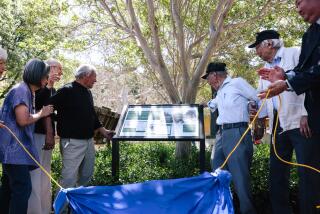Japanese-Americans Put in Camps : K. R. Bendetsen; Helped Plan WWII Internments
- Share via
WASHINGTON — Karl R. Bendetsen, one of the chief architects of the government’s internment of Japanese-Americans in World War II, has died at his home here after a heart attack. He was 81.
Bendetsen, a retired president and chairman of the board of Champion International Corp. of Stamford, Conn., and undersecretary of the Army in the 1950s, died Wednesday.
In 1942, Bendetsen, then a major in the Army provost marshal general’s office, was assigned as a liaison officer between the Justice Department and the Western Defense Command, after officials decided that Japanese-Americans represented a potential threat to national security during World War II.
He devised a system that divided the West Coast into prohibited military zones. He also designed a complex system of passes and permits for Japanese immigrants that the Justice Department and the FBI refused to oversee because of a lack of manpower. That gave supervision of Japanese immigrants, and later Americans of Japanese ancestry, to the Army, which subsequently ordered their internment.
As the controversy over the internment grew over the years, Bendetsen was called on to testify and to give statements on the background of the internment process.
Researchers determined that he had written a letter “saying he didn’t feel it was appropriate (to the government’s position) that the American public know that plans were already in place to intern the Japanese-Americans” even before the attack on Pearl Harbor.
Those who spent time in the camps were eventually awarded reparations.
Bendetsen’s military decorations included the Silver Star, three Bronze Stars, three Legions of Merit and a Distinguished Service Medal. He was also the recipient of the Medal of Freedom, the nation’s highest civilian award.
After the war, Bendetsen resumed his San Francisco law practice. He was appointed assistant secretary of the Army in 1950 and undersecretary in 1952.
He became chairman, president and chief executive officer of Champion Papers, a forest products company, in 1965 and retired in 1972.
From 1980 to 1984, he served as a member of a presidentially appointed commission to study the Strategic Defense Initiative, also known as “Star Wars.”
More to Read
Sign up for Essential California
The most important California stories and recommendations in your inbox every morning.
You may occasionally receive promotional content from the Los Angeles Times.













